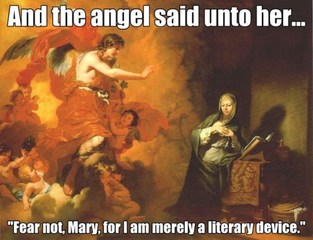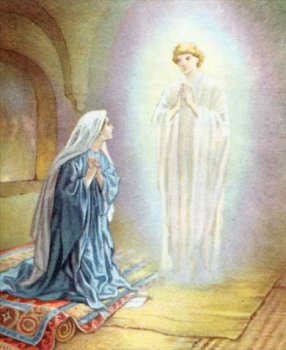THE BLESSED VIRGIN MARY
PROTESTANT SCHOLARS
(Protestant in blue, Orthodox in green)
PROTESTANT SCHOLARS
(Protestant in blue, Orthodox in green)
Gordon Wakefield: Methodist
“Mary is ever woman. The New Testament does not record her as divine. She stands with sinners beneath the cross as the representative not of the kingdom of God but of the Church on earth. The words of Christ in the Johannine passion, `Woman behold thy son’, legitimately allow us to think of Mary as the Mother of the Christian family, the Church.” (Ibid., 157)
Mary in the New Testament
“At the foot of the cross Jesus gives his physical mother a spiritual role as mother of the disciple par excellence, and the disciple a role as her son. Thus there emerges a familial relationship in terms of discipleship .
“A . . . variant of this approach (and one with much older attestation, beginning with Origen) is to treat the mother of Jesus as a general symbol for the church, so that Jesus is leaving the church to the Christians as their mother . . .
“Mary, . . . becomes herself a model of belief and discipleship . . . Most of us did not exclude, but were very hesitant about accepting, a further, secondary symbolism for Mary, whether as the Israel which brings forth Jewish Christianity, Lady Zion, or the new Eve . . . We did see in John’s own symbolic treatment of Jesus’ mother an opening made for the process of further Marian symbolizing within the church.”
(Raymond E. Brown et al, Mary in the New Testament: A Collaborative Assessment by Protestant and Roman Catholic Scholars, Philadelphia: Fortress Press, 1978, 213, 216, 288-289)
Max Thurian
“Jesus addresses His mother in order to commit the disciple to her and only secondly speaks to him in order to commit His mother to his care. If this were only an act of filial love, the first word should surely be addressed to the disciple . . . If Jesus begins with Mary, in order to designate the disciple as her son, it is because this word has more than a purely private interpretation; it has another import . . .
“How, in such an important and solemn context, can the episode of the disciple and Mary alone be accepted as having simply a domestic and private interpretation? . . .
“Mary, called `Woman’ by the Crucified, and then given as `Mother’ to the `disciple,’ is, at the foot of the Cross, the figure of the Church, the consoling Mother of the faithful . . .
“In the Gospel of St. John, neither `the mother’ nor `the disciple’ bear their proper names of Mary and John; they are described by their vocations, . . . they are `types,’ `icons’ of Mother Church and of the faithful brethren of Jesus . . .
“The double phrase used by the Crucified: `Woman, behold thy son; behold thy mother’ recalls the covenant formula of the Old Testament: `I will be to him a Father and he will be to me a son’ (2 Sam 7:14) . . .
“The New Covenant was established between the Father and the beloved disciples, Christ’s brethren, by the motherhood of the Church, the `Jerusalem from on high which is free, our mother’ (Gal 4:26). The Church, symbolized by Mary, receives at the foot of the Cross this maternal mission . . .
“We understand the motherhood of the Church as we meditate on the motherhood of Mary, the mother of the Lord and the mother of the blessed disciple.”
(Mary: Mother of all Christians, translated by Neville B. Cryer, New York: Herder & Herder, 1963 [orig. 1962], 150-151, 160, 162-166)
II. Revelation 12:1, Revelation 12:5, Revelation 12:17
Mary in the New Testament
“Revelation 12 . . . seems to employ the symbolism of a woman described like Israel who is the mother of the messiah and the mother of Christian disciples . . .
“Related to this is the possibility of Mary/Eve symbolism in John 19:25-27 . . . especially since the woman in Revelation 12 is in conflict with a dragon who in 12:9 is specifically identified with the ancient serpent of the Genesis story. According to Gen 3:15 there would be enmity between the serpent and the `woman,’ between the serpent’s seed (offspring) and the woman’s seed (offspring). If the mother of Jesus whom he addresses as `Woman’ has an Eve symbolism, this would be the moment when she would become a mother with seed (offspring), the Christian disciple; and then in the language of Rev 12:17 there would be war between the dragon/serpent on the one side and the woman and her offspring on the other . . .
“We recognized that some major scholars do see in 19:25-27 [of John] one or other of these supplementary symbolisms, and also that it is very difficult to be certain of the limits of Johannine symbolism. In the early post-New Testament period a great deal of symbolism did attach itself to Mary, including some of the symbols we have discussed, e.g., the church, or Eve . . .
“Granted that the woman described in Revelation 12 refers primarily to the people of God, Israel and the Church, is there a possibility of a secondary reference to Mary? The plasticity of apocalyptic symbolism makes a double reference for the one symbol a possibility, and the biblical conception of corporate personality makes it possible for an individual to represent a collectivity. The main argument for a reference to Mary is that the narrative refers to the woman as the mother of the Messiah . . .
“In the Fourth Gospel . . . through the death scene she becomes the mother of the beloved disciple . . . This motif also occurs in Revelation 12, for there the woman is the mother of other offspring who are Christian believers (12:17) . . . The Anglican scholar A. Richardson (Introduction to the Theology of the N.T. [New York: Harper & Row, 1958], 176) thought that Rev 12:17 might imply a double symbolism in which the woman represented both the Jewish Church and Eve/Mary.” (Brown et al, ibid., 217-218, 235, 238)
Max Thurian
“There can be no doubt that this vision of the Woman in conflict with the Dragon reminds us of . . . the `Protoevangel’
(Genesis 3:15).”(Thurian, ibid., 177)
“It is misleading to speak, in this context, of praying `to’ Mary. We pray only to God, whereas we `invoke’ or `call upon’ His Mother: we do not pray to her, but we ask for her prayers – an important distinction. And we are firmly convinced that these requests for her intercession, so far from diminishing our devotion to Christ, serve rather to enrich it.” (Stacpoole, ibid., 174-175)
Max Thurian
“To speak of Mary is to speak of the Church. The two are united in one fundamental vocation – maternity . . .
“Everything that Mary was and experienced, the Church is and should experience, except for what is bound up with Mary’s unique vocation in the incarnation of the Son of God . . .
“In the book of Revelation our vision is directed to the double symbol of the Temple and the Woman, the dwelling-place of God our Saviour: `Then God’s temple in heaven was opened and the ark of the covenant was seen within his temple . . . and a great portent appeared in heaven, a woman clothed with the sun . . .’ (Rev 11:19 – 12:1).
“Thus from the prophetic vision of the people of God awaiting the Messiah under the form of the Daughter of Zion and the Woman and the Tabernacle, up to the final vision of the Temple with the Ark and the Woman clothed with the Sun, it is the same symbolism which one encounters. Mary, on the occasion of the Incarnation, thus gathers up in herself the whole people of Israel in their expectation and symbolizes in herself the whole mystery of the Church in its fulfillment . . .
“Mary is . . . the first Christian woman, the Mother of believers, in the sense that Abraham is called the Father of believers. Abraham inaugerated the old covenant by an act of faith which recalls that of Mary at the dawn of the New Testament. God promises Abraham a posterity when he is old and his wife is sterile [Gen 15:6; Rom 4:18-21] . . . Abraham was for Israel the example of faith par excellence . . . God who had reconciled sterility and motherhood in Sarah and now in Elizabeth, can reconcile in Mary both virginity and motherhood . . .
“This Woman of the Revelation . . . appears as the realization of the messianic hope already foreseen in Genesis; it is the fulfillment of the promise of Victory made to Eve, Woman, the mother of the living, whose offspring `will bruise the serpent’s head.’ This Woman symbolizes Israel, the people of God . . . She symbolizes also the Church which one day will be totally victorious over the powers of evil . . .” (Thurian, ibid., 9-10, 51-52, 61-62, 179)
READ MORE HERE



